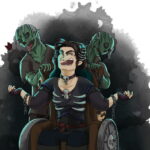Gross Motor Control Loss
You have trouble with larger body movements, such as jumping, throwing, walking, running, and maintaining balance. You have a −(IE) penalty on all melee attack rolls to hit and Strength (Athletics) and Dexterity (Acrobatics) checks and Dexterity saving throws. Spells with somatic components usually need to be modified to work within your physical range, requiring (IE) days for every hour normally needed to inscribe into your spellbook and double the cost due to experimentation materials. You may replace one of your other traits with Muscle Control & Gait Difference.
Real-world Examples
Dyspraxia, Friedreich’s Ataxia, Wilson’s Disease, Parkinson’s Disease, Multiple Sclerosis, Cerebral Palsy, Paraneoplastic Syndromes, Neuropathy, Spinal Injuries
Assistive Options
Leg braces, crutches, walkers, rollators, and canes can reduce the IE penalty by 1 for Dexterity checks and saving throws. Braces take one minute to put on and cannot be worn while sleeping, and the others, unless designed for use as weapons, require one hand to be used for balance.
